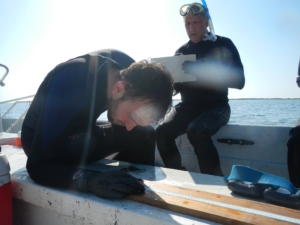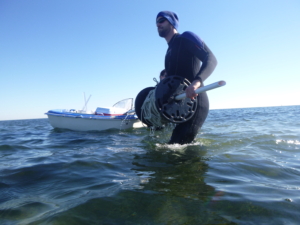After writing a globally-recognized sea grass study in 2018, Jonathan Lefcheck has joined the team at the Marine Global Earth Observatory (MarineGEO), directed by Smithsonian’s Tennenbaum Marine Observatories Network (TMON). MarineGEO is an international and pan-institutional network, directed by the Smithsonian. The Smithsonian Environmental Research Center (SERC) is both a foundational member of the network (along with other Smithsonian units) and the very supportive administrative headquarters of the program. They seek to understand coastal marine ecosystems across the globe, focusing on how biodiversity affects the health of marine life and water quality. The project boasts 13 partners, including study sites in Hong Kong, San Francisco, and Panama. The group aims to ask the same questions and conduct comparable experiments at the different sites so that they can find commonalities in the ecosystems that hold true no matter where you are.

Lefcheck and JJ Orth measuring fish from trawls in South Bay.
Lefcheck has joined the staff as Coordinating Scientist, which means he works on a team to develop research questions, but also has the opportunity to execute experiments as well. He’s excited to “visit some of the research sites. It would be really neat to see some of these species with my own eyes and understand the systems, creatures and habitats I’ve only ever seen on Blue Planet.”
In one of his first projects on the job, Lefcheck and collaborator Emmett Duffy made “squid pops” – dried pieces of squid attached to sticks and deployed at about 40 locations underwater. They wanted to know what predators would nibble on the squid, so they set up cameras and recorded visitors. Although they are still collecting results, this project focuses on similar themes of other projects going on at MarineGEO.
In one ongoing MarineGEO experiment, the team tested sites from Nova Scotia all the way down to Florida to look at biodiversity. They deployed cement tiles to recruit species to latch on so they could observe patterns in the various communities. Scientists have long believed that pressure from predation is higher in the tropics than at higher latitudes, which could be a factor in why there are such a variety of species living in the tropics. To test this idea, some tiles were caged to exclude predators, so scientists can see the effect of predation on species that attach to the tiles in and out of cages.
Just before Lefcheck joined the team in September, MarineGEO and several other partners led a Chesapeake Bay Bioblitz to document the biodiversity of the Bay. A team of researchers came to the VIMS Eastern Shore Lab in Wachapreague, VA to sample a wide range of habitats and collect photographs, genetic barcodes, frozen tissue samples, and voucher specimens that went into the National Museum of Natural History (CRC covered this story in our Summer 2018 newsletter, and you can also read about the project on SERC’s website). The team documented 385 species, 8 of which were previously undocumented. Bioblitzes were also conducted in Hawaii and Vancouver.

Lefcheck running a transect line at Goodwin Island in the York River.
When conducting research in multiple sites that can have vastly different ecosystems, it is crucial to use the same methodology in order to compare results. “We’re building a toolkit of standard procedures to make everything as comparable as possible, even when sites are very different,” Lefcheck explained. The protocols that MarineGEO is working to develop must be able to detect differences in testing sites, and many of the procedures will likely be operationalized by partners during use. For example, if researchers wanted to test sea grass habitats in a variety of sites, they could use a seagrass toolkit that MarineGEO recently developed.
Before joining MarineGEO, Lefcheck says his work at VIMS on sea grasses was related to his current job. “The work I did in Chesapeake Bay really prepared me, as sea grasses are a foundational system worldwide. His paper found that species richness had a positive effect on sea grass recovery, which was contributing to the recovery of the Bay. The paper gained global recognition, including one Washington Post article titled “Why the Chesapeake Bay is the best in the world.” That research was recently validated by an experimental study conducted by Susan Williams.
After leaving VIMS, Lefcheck spent just over a year at the Bigelow Lab for Ocean Sciences in Boothbay, Maine. Scientists have long known that when overfishing occurs, corals can be choked out by algae because reefs have mutualistic relationships with fish that eat the algae. They wanted to know if the biodiversity of fish had any role in coral health. To test that, they submerged GoPros underwater and collected 999 minutes of fish nibbling on algae living on coral reefs. They found that the biodiversity of fish species present was almost as important as the total number of fish. When more species were present, more algae was cropped from the reefs. They also found an effect across sites that showed that the suite of species present at one site mattered relative to the species present at another site. In other words, sites with the same number of species but different composition consumed different amounts of algae. This could help managers better understand the role of both local and regional biodiversity in conservation planning for the corals. He worked with Doug Rasher on this project, and their work is in press in Science Advances.
Lefcheck is excited to continue his work on questions of biodiversity in marine environments at MarineGEO. He is thrilled to be working for a Smithsonian project, calling the experience “invaluable”. “We have great resources, a great campus, and we’re very fortunate to have such great support from SERC and from the Institution.”
